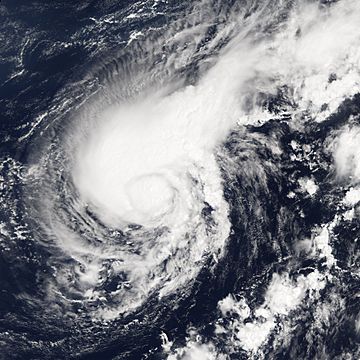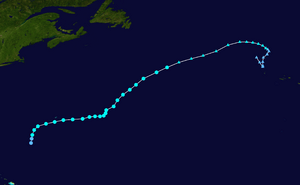Tropical Storm Harvey (2005) facts for kids
| Tropical storm (SSHWS/NWS) | |

Tropical Storm Harvey on August 4.
|
|
| Formed | August 2, 2005 |
|---|---|
| Dissipated | August 8, 2005 |
| Highest winds | 1-minute sustained: 65 mph (100 km/h) |
| Lowest pressure | 994 mbar (hPa); 29.35 inHg |
| Fatalities | None reported |
| Damage | None |
| Areas affected | Bermuda |
| Part of the 2005 Atlantic hurricane season | |
Tropical Storm Harvey was a strong tropical storm. It traveled across the Atlantic Ocean from August 2 to August 8, 2005. Harvey was the eighth named storm of the 2005 Atlantic hurricane season. This storm did not cause any damage.
Harvey started as a tropical wave southwest of Bermuda on August 2. It passed very close to Bermuda on August 4. The storm brought a lot of rain to the island. After that, Harvey moved east and away from Bermuda. It reached its strongest point with winds of 65 mph (100 km/h). Harvey then changed into an extratropical cyclone on August 8. The storm stayed in the northern Atlantic Ocean for a few more days before it finally disappeared.
Contents
How Tropical Storm Harvey Formed and Moved
A tropical wave is like a ripple in the atmosphere. One of these waves moved west from the African coast on July 22, 2005. It crossed the Atlantic Ocean but did not get stronger at first. When the wave reached the Leeward Islands on July 28, weather experts started watching it. They wanted to see if it would become a stronger storm.
By August 2, the weather conditions were better for a storm to form. Tropical Depression Eight began about 350 miles (595 km) southwest of Bermuda. A tropical depression is the first stage of a tropical storm.
The next day, this depression grew into Tropical Storm Harvey. However, there was a lot of "wind shear." Wind shear means winds blowing in different directions or at different speeds at different heights. This made Harvey act a bit like a subtropical cyclone. It also made it harder for forecasters to guess how strong the storm would become.
Harvey passed about 45 miles (75 km) south of Bermuda early on August 4. Its winds were about 60 mph (90 km/h) at that time. After passing Bermuda, Harvey became a "fully tropical" storm. As it moved northeast, it got even stronger. Its winds reached 65 mph (100 km/h). Even with more wind shear, Harvey did not get weaker right away. Its path became a bit hard to predict. Harvey turned into a strong extratropical storm during the night of August 8. This type of storm gets its energy from temperature differences, not warm ocean waters. The storm lasted for a few more days. It finally disappeared northwest of the Azores on August 14.
What Happened When Harvey Approached Bermuda?
When Tropical Storm Harvey got closer to Bermuda, a tropical storm warning was issued. This warning tells people that tropical storm conditions are expected soon. This happened late on August 2. Because the storm might get stronger, a hurricane watch was also given out the next day. A hurricane watch means hurricane conditions are possible.
As the storm moved away from Bermuda on August 4, both the hurricane watch and the tropical storm warning were canceled.
Harvey brought heavy rain to Bermuda. Over 5 inches (130 mm) of rain fell at Bermuda International Airport. This heavy rain caused some roads to flood. Winds of 45 mph (75 km/h) were also reported over Bermuda. Luckily, the storm did not cause any serious damage. No one was hurt or killed on the island.
Naming and Records for Tropical Storm Harvey
Tropical Storm Harvey formed on August 3, 2005. This was the earliest in a season that the eighth tropical storm had ever formed. It broke a previous record. The name Harvey had been used to name a tropical cyclone in the Atlantic four times before. It had been used six times worldwide.
Because Tropical Storm Harvey did not cause any major damage, its name was not "retired." When a storm causes a lot of damage or deaths, its name is usually retired. This means the name won't be used again for another storm. Since Harvey did not cause much harm, the name Harvey was kept. It was used again during the 2011 hurricane season.
Related pages
|
Tropical cyclones of the 2005 Atlantic hurricane season |
|||||||||||||||||||||||||||||||||||||||||||||||
|
|
||||||||||||||||||||||||||||||||||||||||||||||
|
|
|||||||||||||||||||||||||||||||||||||||||||||||
Images for kids



